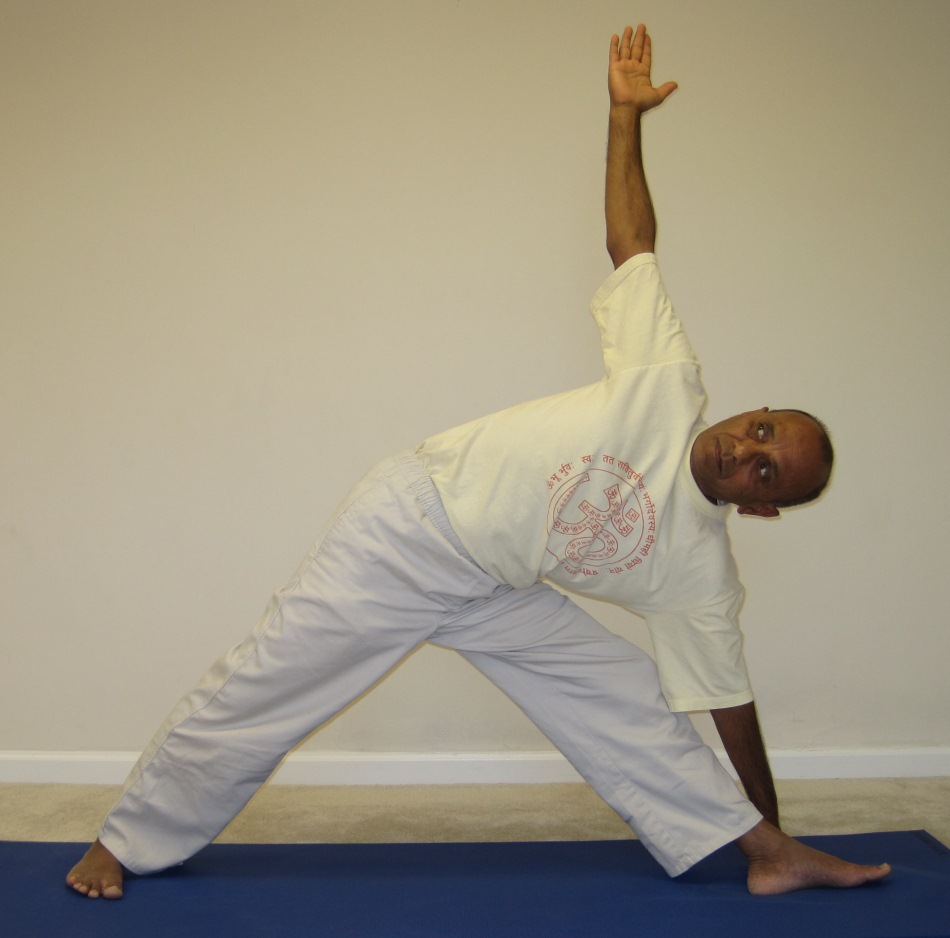
The word "trikona" is composed of two words – "tri" meaning ‘three’ and "kona" meaning ‘angle’. So Trikonasana – त्रिकोणासन
In my own practice, and in the classes that I teach, I like to include Trikonasana as one of the variations in the Sun Salutation (Surya Namaskar) routine. In one of the variations, I start in the Warrior 2 and from there move on to the triangle pose.
Step-by-Step
- Stand erect, facing the long edge of the mat, feet about 3.5 to 4 feet apart.
- Turn the right foot all the way to the right (right angle to the body) and the left foot slightly facing the right foot. Align the right heel with the left heel.
- Stretch the arms horizontal, to the side, in line with the shoulders, palms facing down.
- Extending the torso to the right, while exhaling, start bending over the right leg, bending from the hip area. Keep the left leg strong and press the left heel firmly into your mat.
- While bending to the right, make sure that you are not bending forward and that the heels, hips and shoulders are all in a single vertical plane.
- Slide the right hand down the right leg, going as far as you can, resting the hand on the shin, ankle or the floor on the outside of the right leg, While moving the right hand down, at the same time lift the left arm to a fully vertical position. In the final position, both the hands and the shoulders are aligned in a vertical line.
- Turn your head over the left shoulder, gazing at the left thumb. Maintain your awareness on the breath as well as the experience of stretch specifically in the thighs, hip joints and the spinal column.
- The final position should feel comfortable and you should feel relaxed. Maintain the final position for up to 10 to 15 breaths, if comfortable.
- While inhaling come back up, keeping the left heel firmly on the mat, to the starting position with the arms horizontal. Relax for a couple of breaths.
- Reverse the position of the feet and repeat the above steps on the left side, maintaining the final position for the same duration as on the other side.
- Finally come to a standing position with feet close to each other and relax.
Benefits
- Stretches and strengthens the thighs, knees, and ankles
- Stretches the hips, groins, calves, shoulders, chest, and spine
- Improves posture
- Helps relieve stress, anxiety, nervous depression
- Tone the spinal nerves, abdominal organs, improve the appetite, digestion and circulation, relieve acidity, flatulence and tone the reproductive organs
- Recommended during pregnancy
- Therapeutic for flat feet, infertility, neck pain, osteoporosis, and sciatica
Contraindications and Cautions
- People with lower back problems, herniated disk and neck problems should use caution and consult the yoga teacher for appropriated modifications
- Diarrhea, headache, low or high blood pressure (not controlled through medication), heart condition
Let me know if trikonasna is a part of your yoga practice. I would love to receive your feedback.
Are there any asanas that should be avoided by people with knee problems (e.g., Baker’s cyst, a swelling of fluid behind the knee)?
Thank you.
The basic guideline is that if any pose causes any kind of pain, just don’t go through the asana in pain!
Subash.. Can you please provide the Sutra or origin of Trikonasa where exactly is it mentioned in our ancient scriptures. I could not trace and would be thankful if you provide this knowledge to me and to all.
The Trikonasana is not mentioned in any of the yoga texts that I am familiar with – e.g. the Hatha Yoga pradipika, Gherand Samhita etc. It may have evolved over time as the yoga practices have evolved. If you come across a reference, please do share here.